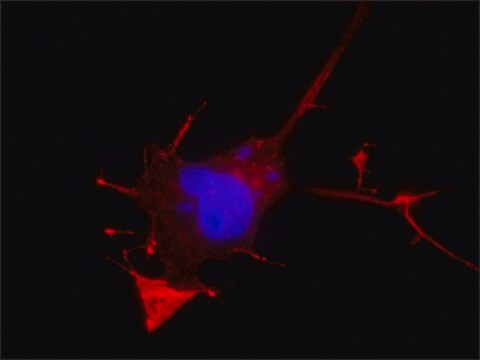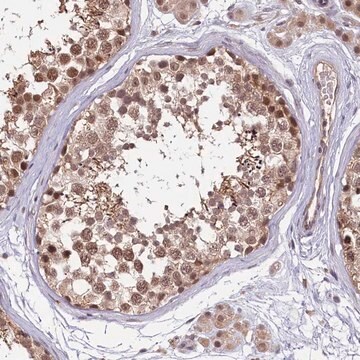추천 제품
생물학적 소스
mouse
Quality Level
결합
unconjugated
항체 형태
purified immunoglobulin
항체 생산 유형
primary antibodies
클론
3E5, monoclonal
양식
buffered aqueous solution
분자량
antigen ~37.11 kDa
종 반응성
human
기술
indirect ELISA: suitable
western blot: 1-5 μg/mL
동형
IgG2aκ
NCBI 수납 번호
UniProt 수납 번호
배송 상태
dry ice
저장 온도
−20°C
타겟 번역 후 변형
unmodified
유전자 정보
human ... UBE3A(7337)
일반 설명
This gene encodes an E3 ubiquitin-protein ligase, part of the ubiquitin protein degradation system. This imprinted gene is maternally expressed in brain and biallelically expressed in other tissues. Maternally inherited deletion of this gene causes Angelman Syndrome, characterized by severe motor and intellectual retardation, ataxia, hypotonia, epilepsy, absence of speech, and characteristic facies. The protein also interacts with the E6 protein of human papillomavirus types 16 and 18, resulting in ubiquitination and proteolysis of tumor protein p53. Alternative splicing of this gene results in three transcript variants encoding three isoforms with different N-termini. Additional transcript variants have been described, but their full length nature has not been determined. (provided by RefSeq)
면역원
UBE3A (AAH09271, 51 a.a. ~ 150 a.a) partial recombinant protein with GST tag. MW of the GST tag alone is 26 KDa.
Sequence
ETFQQLITYKVISNEFNSRNLVNDDDAIVAASKCLKMVYYANVVGGEVDTNHNEEDDEEPIPESSELTLQELLGEERRNKKGPRVDPLETELGVKTLDCR
Sequence
ETFQQLITYKVISNEFNSRNLVNDDDAIVAASKCLKMVYYANVVGGEVDTNHNEEDDEEPIPESSELTLQELLGEERRNKKGPRVDPLETELGVKTLDCR
애플리케이션
Applications in which this antibody has been used successfully, and the associated peer-reviewed papers, are given below.
Immunofluorescence (1 paper)
Immunohistochemistry (1 paper)
Immunofluorescence (1 paper)
Immunohistochemistry (1 paper)
물리적 형태
Solution in phosphate buffered saline, pH 7.4
면책조항
Unless otherwise stated in our catalog or other company documentation accompanying the product(s), our products are intended for research use only and are not to be used for any other purpose, which includes but is not limited to, unauthorized commercial uses, in vitro diagnostic uses, ex vivo or in vivo therapeutic uses or any type of consumption or application to humans or animals.
적합한 제품을 찾을 수 없으신가요?
당사의 제품 선택기 도구.을(를) 시도해 보세요.
Storage Class Code
12 - Non Combustible Liquids
WGK
WGK 1
Flash Point (°F)
Not applicable
Flash Point (°C)
Not applicable
Alain C Burette et al.
The Journal of comparative neurology, 525(2), 233-251 (2016-06-25)
Ubiquitination regulates a broad array of cellular processes, and defective ubiquitination is implicated in several neurological disorders. Loss of the E3 ubiquitin-protein ligase UBE3A causes Angelman syndrome. Despite its clinical importance, the normal role of UBE3A in neurons is still
Janet Berrios et al.
Nature communications, 7, 10702-10702 (2016-02-13)
Motivated reward-seeking behaviours are governed by dopaminergic ventral tegmental area projections to the nucleus accumbens. In addition to dopamine, these mesoaccumbal terminals co-release other neurotransmitters including glutamate and GABA, whose roles in regulating motivated behaviours are currently being investigated. Here
Carissa L Sirois et al.
Human molecular genetics, 29(18), 3021-3031 (2020-08-25)
Loss of UBE3A expression, a gene regulated by genomic imprinting, causes Angelman syndrome (AS), a rare neurodevelopmental disorder. The UBE3A gene encodes an E3 ubiquitin ligase with three known protein isoforms in humans. Studies in mouse suggest that the human
Michael S Sidorov et al.
The Journal of neuroscience : the official journal of the Society for Neuroscience, 38(11), 2671-2682 (2018-02-13)
Angelman syndrome (AS), a neurodevelopmental disorder associated with intellectual disability, is caused by loss of maternal allele expression of UBE3A in neurons. Mouse models of AS faithfully recapitulate disease phenotypes across multiple domains, including behavior. Yet in AS, there has
Eric S McCoy et al.
The Journal of neuroscience : the official journal of the Society for Neuroscience, 37(42), 10230-10239 (2017-09-22)
Angelman syndrome (AS) is a severe neurodevelopmental disorder caused by mutation or deletion of the maternal UBE3A allele. The maternal UBE3A allele is expressed in nearly all neurons of the brain and spinal cord, whereas the paternal UBE3A allele is
자사의 과학자팀은 생명 과학, 재료 과학, 화학 합성, 크로마토그래피, 분석 및 기타 많은 영역을 포함한 모든 과학 분야에 경험이 있습니다..
고객지원팀으로 연락바랍니다.







